Author: Marshall Schott
A common conception when it comes to making hard cider is that, like wine, the source of the must matters a lot with most cider aficionados heartily preferring to use juice from apple varieties not typically snacked on. While some modern cider makers rely on sweet and palatable table apples such as Gala or Pink Lady, traditionally, the varieties viewed as best for hard cider have a more prominent acid and tannic character– Cox Orange Pippin, Herefordshire Redstreak, Kingston Black, and Brown Snout, to name a few.
For those who don’t live near an apple orchard but want to make their own hard cider, acquiring high quality must can be a rather involved task, which has led many to experiment with juices purchased at the local grocer. The range of available options is typically pretty vast with the cheapest being reconstituted from concentrate and filtered to crystal clear, while more spendy juices are often opaque and come straight from the apple press.
My first few experiences drinking hard cider were less than exceptional and caused me wonder whether I actually liked it or not. I was inspired to make my first batch by my brother-in-law, who’d spent some time in Spain where he developed a strong liking of Sidra. Chintzy as I am, I went with the classic Tree Top apple juice dosed with a bit of brown sugar and fermented with Nottingham ale yeast, which produced a boozy beverage Uncle Joe loved but I wasn’t a big fan of. However, there was something I found appealing about the flavor, at least enough to motivate further experimentation using other ale yeasts to ferment cheap juices. Lo and behold, I realized I actually really do like cider, at least the ones I was producing on the cheap and easy.
Expectedly, every time I talk about my approach to making hard cider, others comment that I ought to try it out using a higher quality juice, usually claiming the unfiltered stuff leads to more complex character. Curious to taste the difference for myself, and wanting to have a couple kegs on tap for Uncle Joe’s holiday visit, I decided to put it to the test!
| PURPOSE |
To evaluate the differences between a hard cider made with cheap filtered juice and one made with more expensive unfiltered juice.
| METHODS |
One of the beautiful things about making cider is that the “brew day” consists driving to the store and buying juice, which in the case of this particular experiment required 2 trips to acquire cheap and expensive juices.
Proletariate
Recipe Details
| Batch Size | Boil Time | IBU | SRM | Est. OG | Est. FG | ABV |
|---|---|---|---|---|---|---|
| 5.2 gal | 0 min | 0.0 IBUs | 8.2 SRM | 1.000 | 0.997 | 0.3 % |
| Actuals | 1.054 | 1.002 | 6.9 % | |||
Fermentables
| Name | Amount | % |
|---|---|---|
| Apple Juice: Cheap Filtered OR Expensive Unfiltered | 44.064 lbs | 100 |
Miscs
| Name | Amount | min | Type | |
|---|---|---|---|---|
| Potassium Sorbate | 2.50 tsp | 0 min | Secondary | Other |
| Potassium Metabisulfite | 0.50 tsp | 0 min | Secondary | Other |
| Apple Juice Concentrate | 3.00 Items | 0 min | Bottling | Flavor |
Yeast
| Name | Lab | Attenuation | Temperature |
|---|---|---|---|
| Belle Saison (-) | Lallemand/Danstar | 77% | 59°F - 95°F |
Notes
| Cheap Filtered: 1.049 OG to 1.002 FG = 6.2% ABV Expensive Unfiltered: 1.054 OG to 1.002 FG = 6.9% ABV |
Download
| Download this recipe's BeerXML file |
For the cheap juice, I went with a generic brand I’ve used numerous times in the past that is the cheapest on the shelf at $3.56 per gallon, while the expensive stuff came from Trader Joe’s and ran me $7.98 per gallon, for a difference of $21.10.
In addition to the obvious disparity in appearance, hydrometer measurements show some difference in OG as well, with the expensive unfiltered juice clocking in a few points higher than the cheap clear stuff.
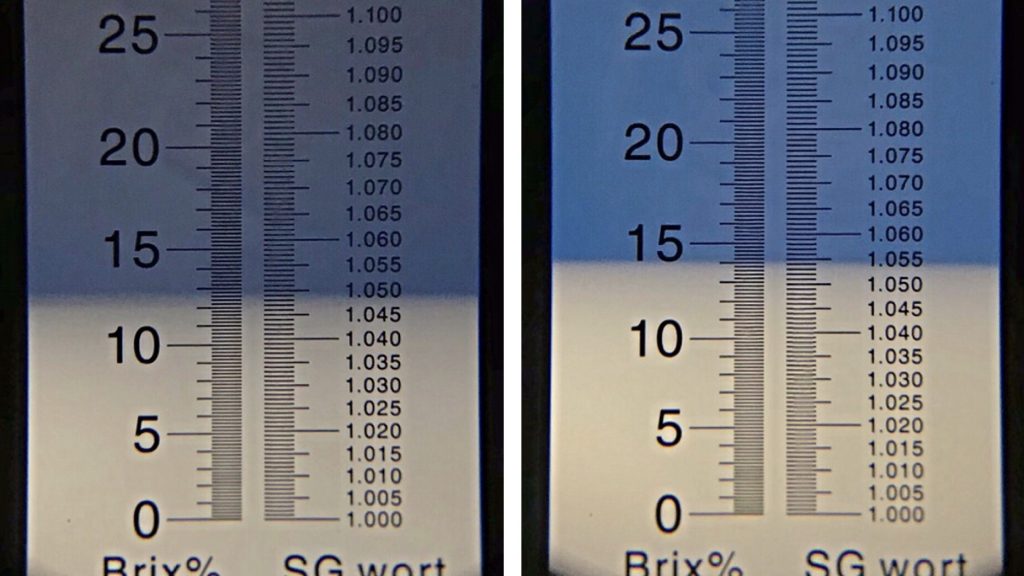
After sanitizing two 6 gallon PET carboys, I added 1/2 tsp of yeast nutrient to each one.
I then poured the juices into each fermentor and pitched a single pack of Lallemand Belle Saison yeast into each, a process that took approximately 10 minutes,
The filled carboys were placed next to each other in a fermentation chamber controlled to 67˚F/19˚C.
A peak at the fermenting juices 12 hours later revealed both had begun fermenting based on the developing kräusen ring and airlock activity.
At 2 days post-pitch, the ciders were happily bubbling away and I noticed the one made with expensive juice had a kräusen that look strikingly similar to what forms during beer fermentation.
After 8 days, activity had died down in both so I took an initial set of hydrometer measurements that showed both ciders had dropped to 1.002 FG, which was unchanged 2 days later, indicating FG had been reached.
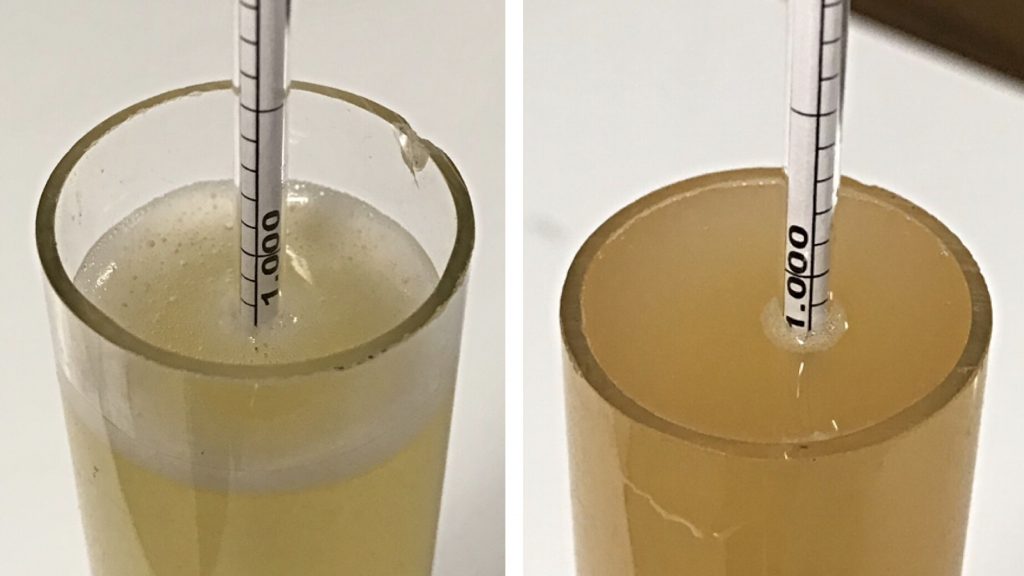
At this point, I added the sulfate and sorbate to both batches, giving them a gentle swirl before leaving them alone overnight. Next, the ciders were crashed to 34˚F/1˚C and left for another day before I proceeded with packaging. The fermented ciders maintained a very stark difference in appearance.
Since we prefer our cider semi-sweet round these here parts, I backsweetened each one with 3 cans of apple juice concentrate, adding it to sanitized kegs prior to transferring.
I swirled the kegs periodically during filling to incorporate the concentrate.
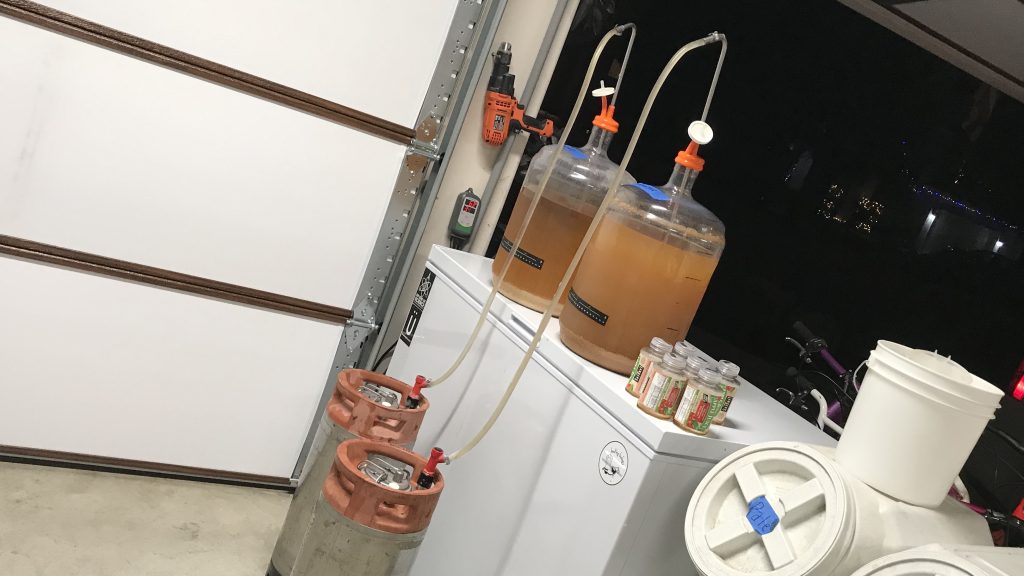
The filled kegs were placed in my cool keezer and burst carbonated at 50 psi for 24 hours before I reduced the gas to 20 psi. After a week of conditioning, the ciders were sparkling and ready to serve, and based on appearance alone, it seemed clear they were different.
| RESULTS |
A total of 20 people of varying levels of experience participated in this experiment. Each participant was served 1 sample of the cider made with cheap filtered juice and 2 samples of the cider made with expensive unfiltered juice in different colored opaque cups then asked to identify the unique sample. At this sample size, 11 tasters (p<0.05) would have had to identify the unique sample in order to reach statistical significance, though only 6 (p=0.70) made the accurate selection, indicating participants in this experiment were unable to reliably distinguish a cider made with cheap filtered juice from one made with expensive unfiltered juice.
My Impressions: This one really got me. From the point of purchasing the juices, I was pretty convinced these ciders would be easily distinguishable based on the fact they looked so different. I did compare the unfermented juices and was surprised with just how similar they tasted, though I thought the unfiltered one had a little more complexity and figured it’d carry through in the finished cider. Once kegged, I compared the samples side by side and, again, felt there was a difference but was caught off guard by the similarity. After witnessing so many tasters make an inaccurate selection on the triangle test, I tried it out for myself 6 times, out which I chose the unique sample twice. For the statistically minded, that’s 1/3, 33.3%, exactly what’s expected from randomly guessing between 3 options. Thankfully, the ciders both turned out delicious!
| DISCUSSION |
There’s a common and understandable belief that “higher end” equates to better quality, which in the case of hard cider typically means juices that are less processed. Indeed, I’d always accepted my preference for ciders made with cheap filtered apple juice as being a sort of Miller Lite of cider, a less complex drink produced for easy mass consumption, while ciders made from nicer juices would please the palates of those with a taste for the finer things in life. It’s for this reason tasters’ inability to reliably distinguish a hard cider made with cheap filtered juice from one made with expensive unfiltered juice is so shocking to me. And I mean that, I did not expect this outcome in the slightest.
When thinking about possible explanations for these results, my first thought was that both were likely produced from sweet table apples, the type commonly snacked on, perhaps even of the same variety. This being the case, the main difference between the juices is that the cheap one was from concentrate, filtered, and had a slightly lower OG. We’ve shown in various xBmts that level of alcohol in beer doesn’t seem to have a huge perceptible impact, and the cheap juice cider was only 0.7% ABV lower than the expensive juice cider. Moreover, based purely on the appearance of the ciders, I presumed the one made with expensive unfiltered juice would have a noticeably heavier mouthfeel, but that just wasn’t the case. In fact, in my own series of 6 triangle tests, a large part of my focus was on body and mouthfeel, but I still only chose the unique sample twice.
Combining my personal experience with the results from this experiment, I can say with confidence I will not be using the expensive unfiltered juice from Trader Joe’s ever again. Not only were the ciders way too similar to justify the expense, but I far preferred the appearance of the cider made with cheap filtered juice. And as much as I enjoy the hard ciders I’ve made over the years, I’m excidered to continue experiment with this delicious drink!
If you have any thoughts about this cider experiment, please do not hesitate to share in the comments section below!
Support Brülosophy In Style!
All designs are available in various colors and sizes on Amazon!
Follow Brülosophy on:
FACEBOOK | TWITTER | INSTAGRAM
If you enjoy this stuff and feel compelled to support Brülosophy, please check out the Support page for details on how you can very easily do so. Thanks!

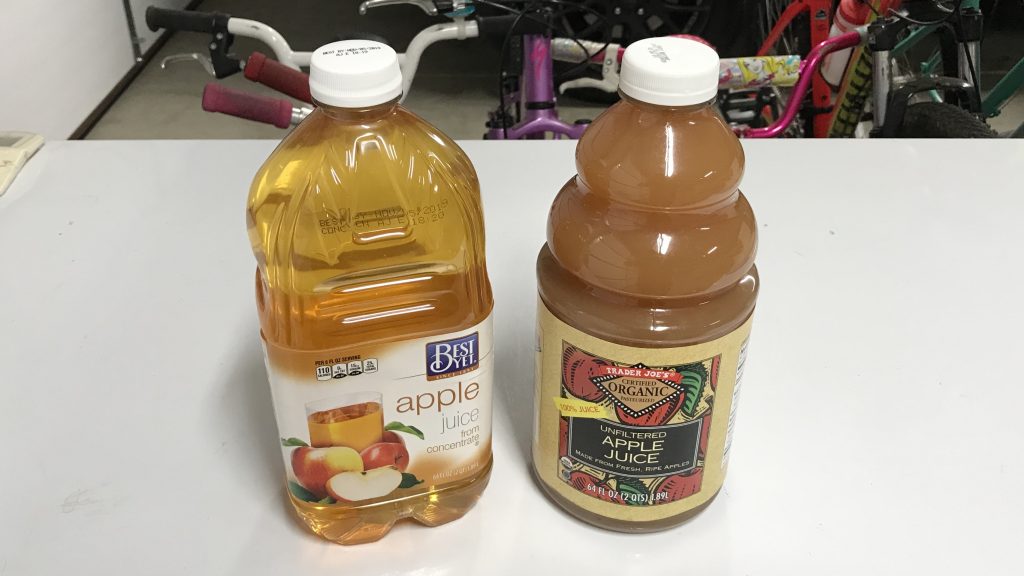
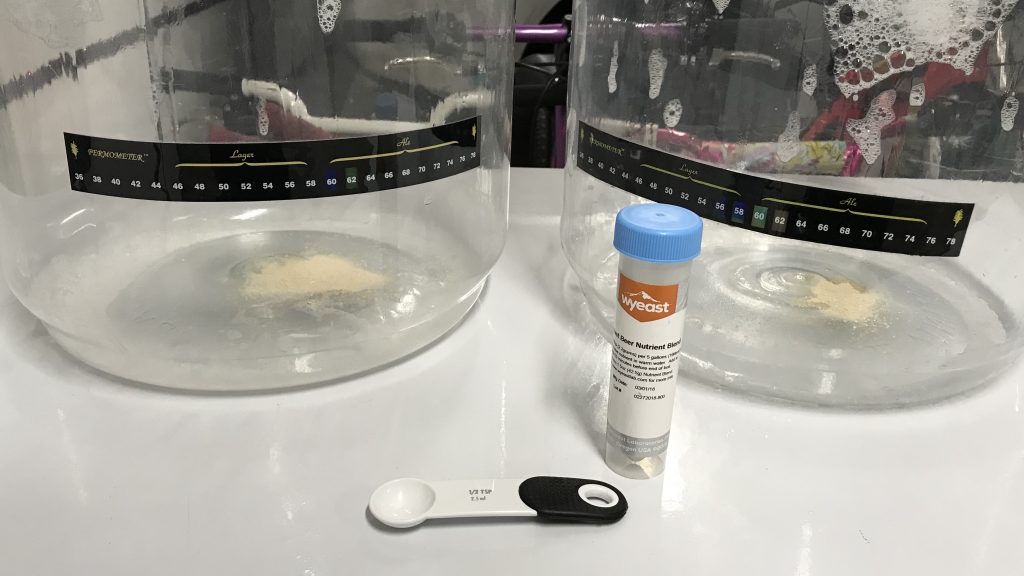
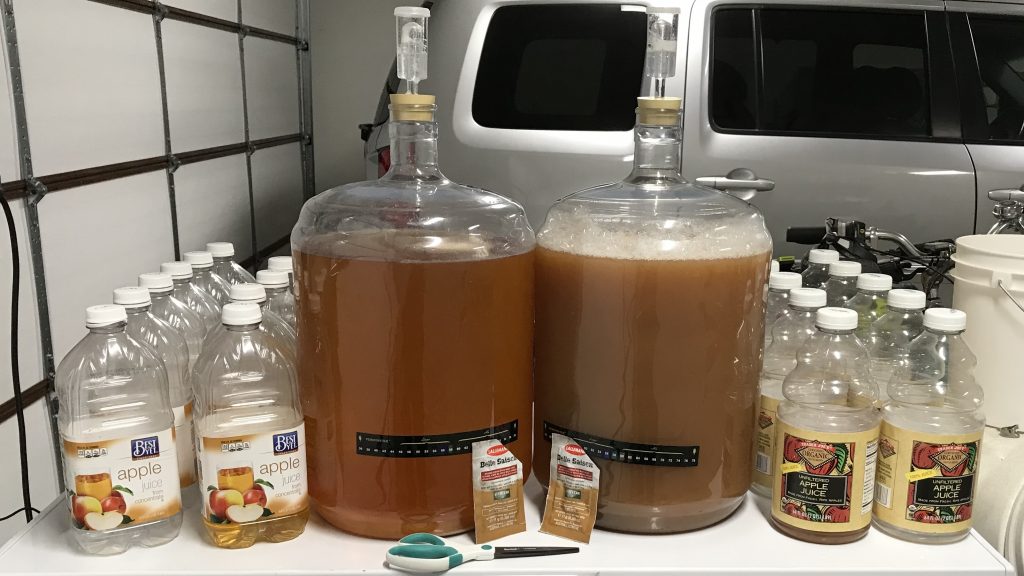
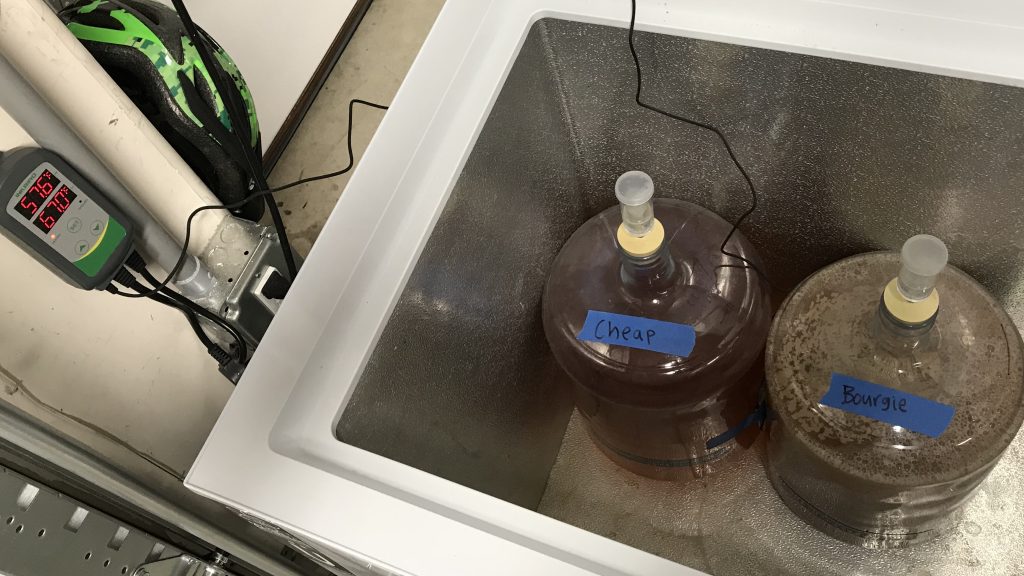
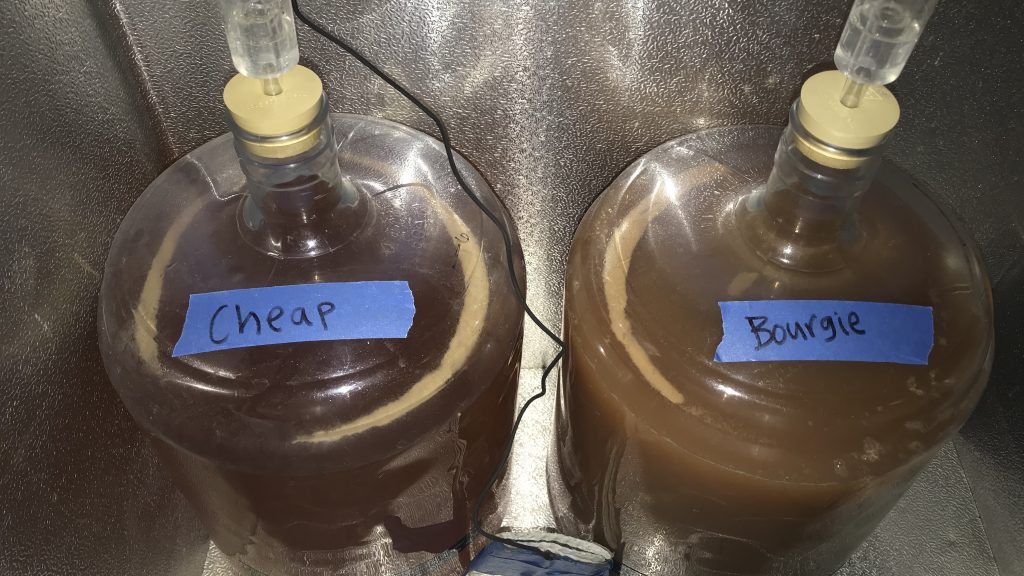
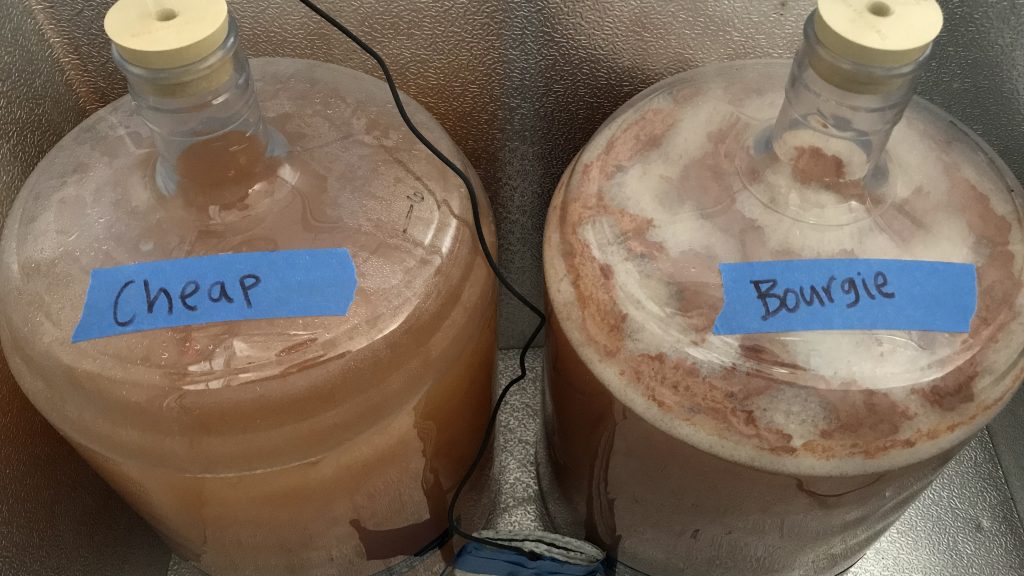
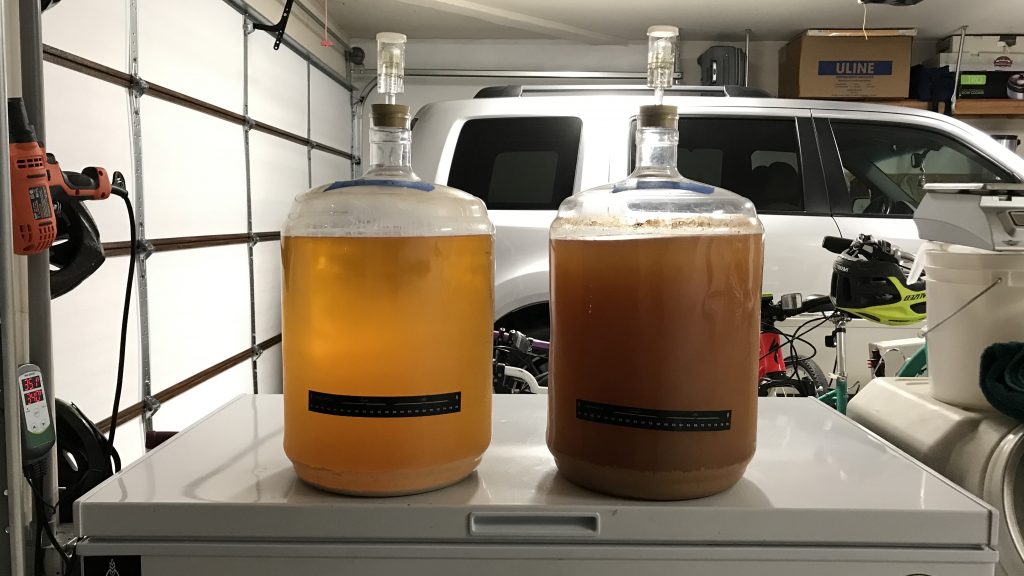
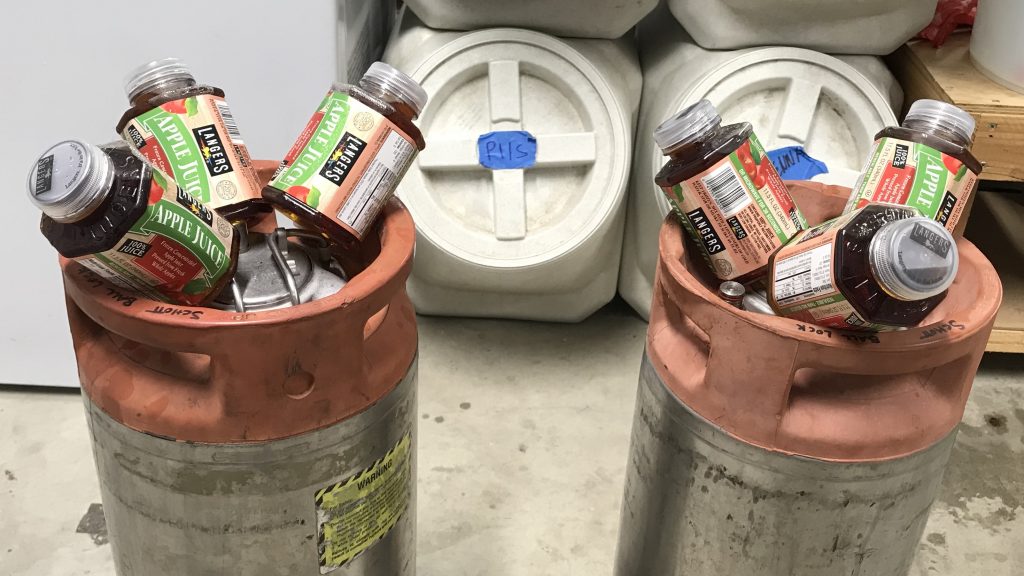
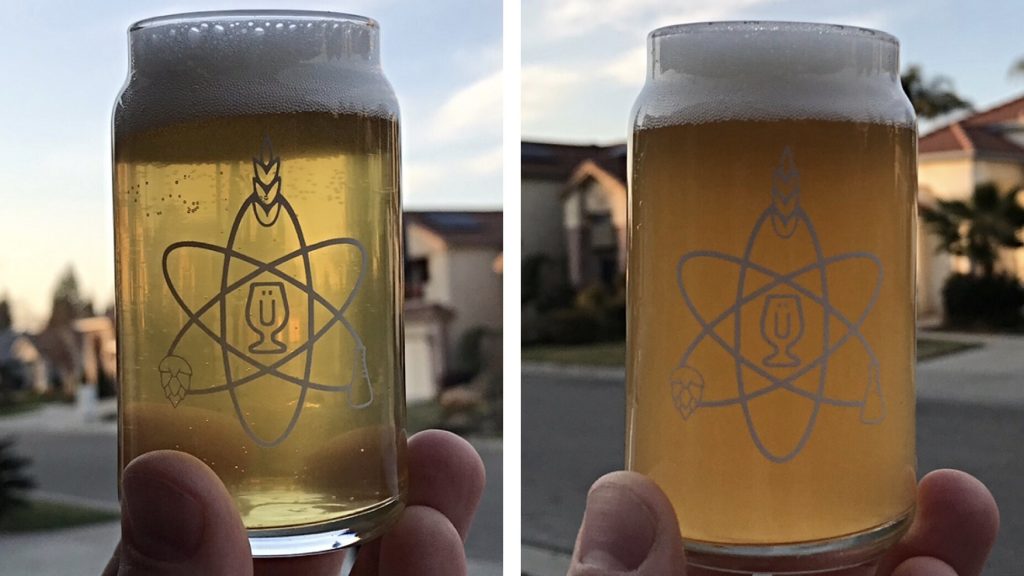










65 thoughts on “exBEERiment | Cheap Filtered Juice vs. Expensive Unfiltered Juice In A Hard Cider”
Thanks for sharing this experiment! I wonder if the back sweetening drove the flavor (same type of juice for each, right/). As both attenuated so low, this might be the big driver in making these so similar. Perhaps if we invest more in the back sweetening juice, we might see a difference. Just a thought.
thanks again!
Exactly my thought. Thanks for writing it! I know my ciders often taste like nothing until backsweetening.
I agree 100% with this. When you backsweeten, the majority of the flavor comes from the concentrate or juice you use. I’m sure that’s more than enough to wash out any potential differences in flacor between the two. If you added Welch’s grape juice to a bottle of Bordeaux and a bottle of Carlo Rossi, they would taste a lot more similar than without the addition.
I’m not sure it’s the majority of the flavor, though certainly some. I don’t really dig super dry cider, around ~1.007 SG is my jam, hence the decision to do that.
Basically what I was going to post. Cider, like wine, takes awhile to really come into it’s own. Short of six to nine months aging it mostly tastes like thin tart water. After enough aging the “apple” flavor comes back. Since this was not aged really at all almost all the flavor is coming from the frozen apple juice you added, you are not really tasting either base cider. While we like our cider dry, I would still recommend folks age it for 6-9 months and then taste it and back sweeten accordingly.
Though, if you like what you are getting, you are sure saving time. I pulled some cider that had four years on it and it was amazing.
I have no doubt that your method results in great cider, especially if you like it on the dry side. Personally, I like my cider on the sweeter side and I can go from orchard to keg in less than 3 weeks. I think backsweetening with fresh juice, and adding a bit of yeast nutrient at pitching let’s you drink it young.
Thanks for such a detailed right up on your process for making cider! For someone who is still contemplating making a cider, this type of step by step detail really helps get me motivated. Cheers and Happy NewYear!
Thanks, I have wondered about this extensively as many cider aficionados claim you cannot use the processed stuff since it contains ascorbic acid which affects the fermentation. Now please do one using “cider” apples and see if that makes a noticeable difference.
I think it’s sorbate that you need to worry about in commercial juice. Ascorbate simply gets used up in fermentation . Sorbate gets metabolized into geraniol – ok(ish) in beer but horrible in wine. Always check your juices before fermenting! Many use UV or sulfite instead which are ok.
Oops, my error. I forgot. Sorbate actually gets converted into geraniol by malolactic bacteria, not yeast. (I was using blackberry puree in my merlot a few years ago and this ws a potential concern.)
Hi Derrick, I have done store bought cider for years and then had the opportunity with a cider group to go to an apple orchard that grew cider apples to press our apple juice the past two seasons. I can tell you from personal experience cider apples make better ciders, in my opinion, compared to the store juice made with just sugar apples.
Everyone says they don’t care for dry ciders. I can understand why but with dry cider made from cider apples is a whole other story and doesn’t need back sweeten. From all that I have read on cider, cider apples contain tannins and acidity that sugar apples lack and this makes a big difference in the taste of cider.
I do feel that most people when they try cider made from cider apples may not appreciate it because it is different from ciders like angry orchard and woodchuck. The comparison isn’t much different than dry wines to wine coolers. Even if you don’t like dry wine I am sure you can tell that there is more depth and complexity of these wines compared to a wine cooler.
So in conclusion it would be very easy to distinguish between cider made from sugar apples and cider made from cider apples, even if you are not a cider expert. Cheers!
I would be interested to see this done again, using a cleaner yeast, without back sweetening.
The saison yeast and amount of applejuice concentrate at kegging (both which I prefer myself for ciders as well) have strong flavor characteristics, and may have masked the differences in flavor of the original juice.
Thanks for the experiment, I probably won’t bother using more expensive juice anymore when making cider using a yeast with strong flavor characteristics and back-sweetening!
Yuck, at least you could’ve gotten some unpasteurized cider from a local farm, maybe made from real cider apples and not eating apples.
Read the article, cripes… The entire point was comparing grocery store ciders for the benefit of those who don’t live near orchards and don’t have other options.
Not everyone lives by a damn orchard .. many people are south of the Mason Dixie where apple trees don’t grow because they need a cold frost each year.
It’s almost like this was mentioned in the second paragraph! “For those who don’t live near an apple orchard but want to make their own hard cider….”
To the pit of misery! Dilly Dilly
I’m also curious if the back sweetener covered up the differences between the two fermented juices. Did you sample them before have sweetening by chance?
Yep, it’s the apple varietals, not the filtration. Not to be blunt, but pretty much anyone who makes cider for a living could tell you that. Home brewers who make cider are kind of weird this way, they worship beer advice from brewmasters but entirely ignore centuries of wisdom from pro cidermakers.
Backsweetening with the same juice concentrate changes any perception of difference you would get in those two juices. It’s just like taking two similar beers and dosing them with the same flavor extract.
I imagine the differences would have been much more noticeable in the unsweetened versions. If I am backsweetening I use cheaper juice as the flavor can be very austere once fermented. If I use pressed cider it’s a completely different product.
Keep an eye out for family owned commercial cider producers who make fresh apple juice available to homebrewers. This year, I was able to participate in pressing the apple cider I brought home for fermentation; it was a wonderful experience and the cider is delicious.
Perhaps back sweetening with the same juice you used as a fermentation base would have been more appropriate. Or testing without back sweetening.
I have made ciders from kits (mangrove jack as an example), store bought bottled apple juice (like with this experiment) and local organic apple cider from an orchard (I live in Oregon). They’ve all been pretty good (only with a little backsweetening, not 3 cans of concentrate…), but like this experiment, the expense of the local orchard apple cider wasn’t a big enough difference to warrant continuing using that source of apple juice. Drink what you like!
Haha – you called the TJ juice Bourgie! Nice.
Hey, I’ve been playing with your Hard Berry Cider recipe and we love it! It’s rare that my wife joins me in drinking things I brew (she doesn’t like beer) so it’s awesome to have something she likes on tap. I’ll keep getting the cheap stuff, I’m glad you did this experiment.
Stats nerd here. A few comments:
“participants in this experiment were unable to reliably distinguish a cider made with cheap filtered juice from one made with expensive unfiltered juice”.
This is simply not true. All that this experiment established is that you are unable to say that tasters are able to distinguish between the two juices. With a bigger sample size, you would probably achieve statistical significance.
“It’s for this reason tasters’ inability to reliably distinguish a hard cider made with cheap filtered juice from one made with expensive unfiltered juice is so shocking to me. And I mean that, I did not expect this outcome in the slightest.”
With all due respect, the result is not nearly as sexy as you suggest. You did not establish that the juices are indistiguishable. You simply established that you cannot say with certainty that the juices are distinguishable. Those are very different conclusions.
With all due respect, I never suggested they were sexy.
Well, you were “shocked” by a result — non-significance with a sample size of 20 — which is, from a statistical perspective, not at all shocking or unexpected. With a sample size of 20 you are going to have a ton of non-significant results woth variables that actually have a major effect.
From a statistical perspective, a more accurate but less sexy discussion of this result would be: “Well, we can’t draw any conclusions from this result. Maybe expensive cider is better — we just can’t say. Happy new year everyone!”
Maybe you should refocus this blog on your own subjective experiences? That’s why I read the blog and why I love it. Anyhow, Happy New Year!
I was shocked by my personal experience in conjunction with the fact less than 1/3 of tasters could tell them apart.
From a statistical perspective, we never make any conclusions. We share results. About alcoholic beverages. And let the adults who read said results decide what to do with them.
Happy new year!
Semi-stats guy here. I don’t think the intention is to be intensely rigorous; just to do an interesting experiment that the readership can use as food (or drink) for thought. Of course you can argue about low statistical power and how limiting that is. As a scientist, I could be critical that the experiment was conducted exactly once. Even if the testers did detect the odd drink out, I would always wonder/worry that the result is from a single experiment. We can debate about whether any result is “sexy” some other time…
I’m not criticizing the experiment or any lack of rigor. I’m just criticizing how the experiment is being (mis) reported. This blog consistently reports non-significant results as if they suggest that the variable has no effect, which is just plain wrong and undoubtedly misleads a lot of the readership.
We make a very pointed effort not to imply that variables have no effect, but we can’t control how people choose to interpret the results. From the article in question:
It’s pretty clearly not a sweeping statement, I very intentionally qualified that these results were from this specific experiment with these specific tasters. I’ll be honest, when someone gets so caught up in tearing apart one of our experiments by deferring not only to their understanding of stats (whether actual credentials are supplied or not), but also continually nitpicking our methods or the way we report the findings, it’s hard for me not to assume something else at play. Regardless, that’s neither here nor there, my suggestion to people who don’t like our approach is to do it for yourself, collect data in the way you think is best from hundreds of participants, write it up in your preferred way, and please do share what you find!
These experiments are awesome and I enjoy reading your results as they motivate me to either try them myself, or help decide on various paths. I believe the majority of your readers are not parsing the concluding statements with such rigor and taking these experiments for what they’re worth – that is, looking into whether or not your group can see a difference in using a particular technique or ingredient that has posed to be of questionable value. At least, that’s what I’m after. The rigor part – or whatever statistical depths I wish to delve – is up to me, if I chose to continue the tests myself.
Keep on keeping on Marshall!
Marshall, I have no ulterior motive and I am a true fan of what you do. I am only making this point to try to bring greater technical accuracy to the blog.
Your reply unfortunately seems to show that you don’t understand my point. When you say that the experiment indicates that “participants in this experiment were unable to reliably distinguish the ciders”, that’s wrong! The experiment only indicates that you can’t say that participants were able to distinguish the ciders. Big difference! Do you understand?
Misreporting a non-significant result the way that you do is misleading and leaves the misimpression that, based on the experiment, cheap cider might be indistinguishable from expensive cider. That’s not what the result indicates at all, and it shouldn’t be reported that way.
It’s a fair criticism — don’t take it personally.
Hey MJC,
I feel like you are the reporter asking Allen Iverson about missing practice way back when. His reply “Are we really gonna talk about practice…practice…we gonna talk about practice?” Lol. If you don’t know what I’m talking about, please Google.
We are just talking about beer! Or in this case cider. This isn’t a high tech lab looking for the next big drug to cure the incurable disease. Just give it a rest. You are only making yourself look worse by trying to argue your point with everyone, right or wrong.
If we ever meet, I promise to buy you a beer. We can sit and reminisce about that one time you went too hard in the paint online and kept getting roasted for it. Hopefully we can all laugh about it. Maybe even Marshall will come too, who knows. Cheers!
It seems like the best response anyone can come up with to my very straightforward technical comment is to say “chill out, it’s only homebrew”.
To that, I say: If anyone needs to chill out, it’s Brulosophy that should chill out with misreporting the implications of non-significant results. It’s a basic, undergrad-level error. Misusing the T-test gives the blog a veneer of statistical rigor that isn’t actually there, and causes a lot of readers to erroneously conclude that certain brewing practices have no effect, when in fact they almost certainly would with a larger sample size.
Maybe the blog should just chill out and report the results without misusing the T-test, or should just focus on the subjective results?
Also, people need to stop getting so defensive. This is a technical debate — chill out!
We’ll do us, you do you, it’s all good. Cheers!
Okay, I’ll do me and continue to point out when you misstate the meaning of a non-significant result. You do you and continue to mislead your readers by suggesting that non-significant results suggest that the variables in question have no distinguishable impact. Cheers!
You’re clearly misled, we never claim “non-significant results suggest that the variables in question have no distinguishable impact,” but that in a particular xBmt, the variable in question didn’t seem to produce a noticeable difference. You’re the one extrapolating, which is perfectly fine, though I think your energy would be better invested in performing your own experiments in the way you feel is best and sharing the results rather than cynically assuming our readers are ignorant pushovers who can’t think for themselves…
Marshall, if you just said that the variable in question didn’t seem to produce a noticeable difference, I would have no issue. That would be subjective, and would be totally valid from a methodological perspective. You could even report the subjective experiences of multiple participants (perhaps informed by a blind triangle tasting), which would be great.
Instead, you run a T-test and, if the result is non-significant, you state that it indicates that “participants in this experiment were unable to reliably distinguish” the two beers. Again, that is totally wrong and misleading. When you get a non-significant result, you should be reporting that the result is inconclusive with regard to whether participants can distinguish the beers or not. That’s the only conclusion you can draw from a non-significant T-test result. (But, again, reporting on people’s subjective experiences is totally valid and is why I love the blog!)
I am curious about your methods for making cider. You added the sorbate and sulfate into the primary. Many recipes suggest transferring to a secondary then adding the chemicals. What has been your experience?
Also can get some info about your transfer method.
Thanks
I don’t use secondary for anything, haven’t in years. You could add chemicals in secondary if that’s your jam, not an issue. I transfer from carboy to keg using a sterile siphon starter into the liquid disconnect.
I am also curious about your transfer method, I see in the picture of the transfer that you use sterile siphon, into the liquid disconnect. Do you take the other keg post off? it looks like some kind of white cap on the other post?
Any particular reason why the expected OG is 1.000 and the expected FG is .997? Brewing software?
Yeah, software issues.
Two comments:
The more expensive juice was produced from organically grown apples, which some folks might care enough to pay extra for, for all of the environmental benefits that organic production give.
The best cider I’ve ever made was with fresh pressed juice, unpasteurized, unfiltered, from non-cider varieties, with no yeast pitched into it. I found that using the naturally occurring yeast from the fruit gave the finished cider the best apple aroma and flavor. Far better than pitching the commercial yeasts in the same juice.
I’m intrested why a Saision yeast and not a cider yeast or a champagne yeast?
I prefer it to ciders myself and others have made with cider/wine yeasts.
Thank you for writing up this experiment, it is good information!
1 Tablespoon of pectic added at pitch will clarify the TJ juice just fine.
Great write up, and it was an awesome experience tasting those ciders in the triangle test. Ignore the naysayers and keep doing what you do Marshall! All of your testing is helpful and useful, regardless of “academic rigor” that some might want to bring up. Cheers!
What you have done is great for very quick cider making. Chris is right, pectic enzyme will clear up any cloudy fruit drink. For those that are interested, you don’t need a whole orchard. A single apple tree will yield a lot of apples. The variety of apple matters big time. I have access to two apple trees, but only use one because of the difference in the taste of the resulting cider. I run them through a grinder and then a grape press. It is a lot of work for great tasting cider. your method is much quicker 🙂
Thank you for doing these experiments, Marshall and Crew.
I appreciate what you guys do, and I find it interesting, relaxing, and helpful. Beer talk. Not a cure for cancer, and not a political argument about global warming,just a chat about beer. I am surprised when some prefer to find ways to criticize and belittle, but I guess that is the internet.
I also think it is entirely possible that you are just a bunch of guys who make beer in the garage and try various things out to see if there is a noticeable change in taste after trying different things with process and recipe variations. That is a cool idea and I like to read about it because, I like beer,I make beer, and it’s fun. Nothing more,and nothing less.
I found no real difference between using more expensive juice and cheap juice in my experience either. Both were store bought juice, and not sourced from an orchard, as that is not possible in the part of the country I live in.
I am not a scientist,and I can’t provide statistical analysis, so my taste test may be invalid. The Johnny Appleseed in me says save the money on expensive juice,however.
Happy New Year to you, gentlemen! Please don’t let the few spoil it for the many.
Thanks for another useful (for my brewery) xbmt…. And, for yet again drawing out the scientific experts in the com-box… Your xbmts are the gift that keeps on giving
I made my 1st cider with an apple farm cider. Made the next, and all subsequent, with grocery store apple juice and came to the same conclusion as this xbmt. Even when I cold-crash at 1.010 and keg, thus not adding any back-sweetener, I still can’t tell them apart.
Awesome! I’ve got the same experiment going on right now except with cider fermented dry with champagne yeast. They need to bottle condition for another week before I’ll have results though. Left both in the fermenters for several months, the reconstituted juice was crystal clear but the pressed cider never dropped clear despite way more sedimentation. The OG of the reconstituted juice was actually higher in the juices I got (and comparing nutrition labels seems to be the same brand to brand) so the OG of the fancy juices may may vary more.
I usually add concentrate before fermentation to bump up the OG, to me it also seems to add a little apple flavor (maybe a future test?).
Using probiotics to make a sour cider has been a hit too.
As I have two apple trees in my yard and there are many others growing “feral” in this area (eastern Mass.), I almost always make cider from fresh juice I have pressed. I find that the flavor of the finished cider is more complex if I use multiple varieties. In particular, since most large apples you can find growing in urban/suburban locations are sweet eating apples, I try to spice up the mix with crabapples. These add a level of acidity and tannic complexity that the eating apples are missing. Crabapples are growing everywhere. They are completely edible although usually too bitter for eating straight. They have plenty of sugar in them. I use about 15%. Since I bottle condition, I ferment completely dry else the bottles will over carbonate or even explode. The results seem to met with general approval. Apropos this discussion, in years where I have had a crop failure, I have used commercial sweet cider either from a local farm or from Whole Foods where the cider has not been pasteurized but not treated with sorbate. The results on both are good, but missing a bit of the complexity of my more eclectic mix. If you have access to a store like Whole Foods, it is worth looking for their jugs of sweet cider as a base.
I meant to say that the Whole Foods cider was pasteurized. That evil “not” must have crept in on its own. 🙂
I also enjoy my cider slightly sweeter than Scrumpy, but rather than back-sweeten with concentrate (cheating 😏), I just taste the fermenting juice every day after 2 or 3 days and then stop fermentation when the flavor and “mouthfeel” seem right. I either cold crash it close to freezing or filter it through a 1 micron filter to remove yeast. It usually is about 3% ABV.
I keg it and carbonate it, then usually transfer whatever amount I will be using into plastic bottles with carbonation caps so I can re-carbonate the bottle if I don’t finish it.
Dan
I’ve been making cider for about 15 years now and in that time many, many experiments have been performed. A couple things I noted were I prefer cheap juice over most expensive brands and every single batch of unfiltered natural cider juice I used never yielded a result worth the extra expense. I’ve been questioned on that over and over. Always a doubter to find in the home brewing community. I brew beer and make cider for my wife and I to enjoy not the general public so we drink what we like. I happen to thoroughly enjoy the Motts plain old juice best. In fact I would go so far as to say the fancy unfiltered juice made my least enjoyable ciders. I don’t back sweeten, I keg and sometimes bottle condition for a year or 2.
In addition to Matt M above, I’ve seen several others claim that ageing the cider in the bottle brings back more of the apple flavor. I don’t have the patience to test that.
I’m planning on copying your open fermentation experiments with my next batch of cider to see if increased oxygen exposure during fermentation improves apple character. Sample size is only me and the wife so if you guys or anyone else want to try it out I’d be interested in hearing the results.
So I forgot to post my follow-up. Have tried the open (fermenter covered with a rag soaked in sanitizer) vs. closed fermentation twice now. Bottom line, my wife and I can detect a difference in flavor but don’t have a strong preference either way. Keep in mind I bottle condition so am getting oxygen exposure at bottling that may eliminate some differences. I thought the open fermented cider had a rounder flavor while closed was slightly more tart/sharp, the open fermented cider also finished much quicker. Additional notes below:
1st time. I didn’t control well enough because I was impatient (had one gallon of juice on hand, and started a fermentation with it then started the other a week later after I made it to the store to get more juice…the color of the two never matched, at first I thought it was from the Oxygen exposure, but the open fermented one was lighter colored and apparently O2 should darken the juice (just like cut apples turn brown), I noticed at the store the next time that there was a pretty wide variety in the color of the juice with that brand so I think that was actually the cause. The closed fermentation took a long time for airlock activity to stop; I left the open fermentation open for the entire duration (at least a month). At bottling I noticed a sweeter, Sherry like flavor in the open fermented cider; but after carbonating didn’t notice any sherry taste. I think that flavor difference might have persisted in a kegged/force carbed cider.
2nd time. Better controls, bought both gallons of juice at the same time and ensured they were mixed together split between both fermenters. Used repitched yeast from the dregs of some bottles of cider but it was also mixed together prior to being split between the fermenters. Since the closed fermentation took so long previously (underpitching and no yeast nutrient addition) I added an airlock to the open fermented one after the first two weeks. The open fermented gallon started more vigorously and airlock activity ceased long before the gallon that had an airlock the whole time. At bottling both tasted very similar. After carbonation I can notice a slight difference, the open fermented one seems to have a slightly rounder taste while the closed fermentation has slightly more sharpness/tartness. I like them both
I love this site and really appreciate you doing all the experiments I’m always curious about but not willing to do double batches to test. On this one I’m surprised though. I’ve done this test myself and noticed a substantial difference between “good” cider and “cheap” cider. We don’t back-sweeten though because we like our cider dry. If you ever try this again, and can stand dry cider, you might try that. I think you’ll find that it’s a more noticeable difference when you’re not covering it up with concentrate.
Hi Colin, thanks for the feedback. As the person who made these ciders, I was shocked at how incredibly similar they were. While it’s possible the back-sweetening is what made them taste so similar, someone also proposed the lack of extended aging as being a possible culprit, the idea being that the ciders may have matured differently over time.
As someone who likes neither dry cider nor waiting, I’m not sure I’ll be the one re-doing this xBmt, but it’s certainly something we’ve got on the list!
Very good experiment. The last batch I made from fresh pressed unpasteurized cider turned out very thin tasting so instead of using concentrate from the store I made my own concentrate by freezing the same unbrewed cider and draining the heavy flavorful taste out which two gallons reduced to one quart that made the cider perfect and the best I’ve ever made
Not trying to beat a dead horse here, but wanted to share my experience. Living in the Pittsburgh, PA area we are lucky to have a few apple orchard farms where they press their own apples. They’ll even sell you the freshly pressed juice w/o preservatives (even heat nor ascorbic acid) for making cider. I bring a sanitized fermenter and they sell it to you for $4-5 a gallon. I can tell you that if sampled beside a filtered, cheap store bought juice…you will taste a difference. Even if just in mouthfeel alone.
However, once it is fully fermented out, I can’t taste a difference. Because of this, I now buy the similar stuff (mentioned in your article) as my base which is even cheaper. The only time I would not do this is if you were to halt fermentation once hitting your desired FG instead of letting it ferment all the way out and back-sweetening. I’m too lazy to do this, so I ferment the cheap stuff all the way out and back sweeten.
Sometimes doing it exactly as you are and it tastes great. However, I’ve recently tried a different method. Do a 4-4.5 gallon batch and add a lb or two of simple table sugar to the fermenter to raise the final ABV to %7-%8. Then buy good juice (1/2 gallon – 1 gallon) for back-sweetening and not concentrate. That then dilutes the higher ABV back down to where you want it, but without adding concentrate. Sipping one as I type and it’s the best cider I’ve made and I’ve been making them for years.
As a side thing, after listening to Marshal talk about using Belle Saison dry yeast I decided to give that a try. It’s finished fermenting, but still in the fermenter. This was with cheap, clear juice. This is the first time I’ve had a huge krausen on a cider. So much so I even took a picture of it. It was like I was fermenting a hefeweizen! So, not sure what the similarity is with the juice I used and that Trader Joe’s juice was, but normally it’s little to (and more so) no krausen with the same juice.
Thanks for all the great articles, podcasts and now the show!
Cheep juice works fine. You can add wine tannin or black tea if you want. Maybe some malic acid. My suggestion, split each batch and only backsweeten half. Or do yourself a favor and try adding mosaic cryo hops at krausen. I use about 1/2 oz per gallon. If you backsweeten with concentrate, you will notice the effect it has on final product.
In my experience yeast and fermentation temperature as well as what you backsweeten with and aging make a big difference. But if you use something like all granny smith vs all honeycrisp, you’ll notice a much bigger difference than when just using cheep vs expensive juice.